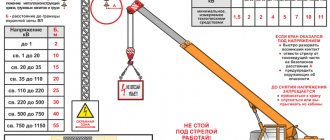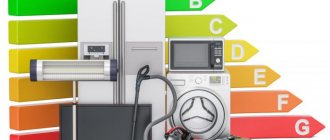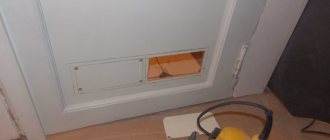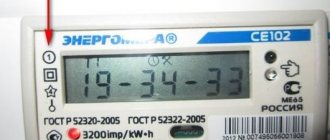From this article you will learn what a room zone class according to fire safety is, how this concept differs from the concept of “room category according to fire safety”, what are the classes of room zones according to the PUE and according to the Technical Regulations, and you will get acquainted with the main points of the methodology for determining these classes.
Rice. 1. Signs indicating the room category and fire safety class of the room area
A sign indicating the category of the premises and the class of the premises area according to industrial safety must be placed on the doors of production and warehouse premises. A similar sign is placed on outdoor installations. This requirement is given in paragraph 20 of the Decree “On the fire safety regime”. The importance of its compliance is evidenced by the fact that the same clause places responsibility for the presence of such a sign on the head of the company or organization.
Let's figure out what the fire safety zone class of a room is, how it differs from the fire safety category of a room, how and when it needs to be determined.
Rice. 2. Decoding the information indicated on the signs of categories and zones of premises
What is a room category according to fire safety regulations and a room zone class according to fire safety regulations, their differences
Federal Law No. 123 of July 22, 2008 (“Technical Regulations”) requires the division of production and warehouse premises into categories according to industrial safety . There is no need to do this with other types of premises (for example, household, commercial). Fire authorities rightly believe that if flammable or explosive substances (for example, methane) are constantly involved in the production process, they are more likely to ignite or explode than would happen, for example, in a residential building (methane is not used constantly, and from time to time).
In total, there are 5 categories of premises according to industrial safety. They are designated by letters from A (the most dangerous) to D (the safest), while category B is divided into 4 subcategories - from B1 to B4 . The characteristics of each are given in special tables and calculated using methods. Read more about this: Categories of premises according to explosion and fire hazards
Classes of fire safety zones for premises are also allocated for warehouse and industrial premises. In this case, you should be guided by the requirements set out in the PUE.
The class of the area of the room according to the PUE is determined in order to correctly select electrical equipment that will successfully operate in fire and explosion hazardous areas. Fire hazardous areas are located inside or outside production premises.
Determination of categories of premises according to explosion and fire hazard, zone class according to PUE
Determination of the categories of premises, buildings and external installations for explosion and fire hazard, as well as the class of the zone according to the PUE (Rules for the Construction of Electrical Installations), according to the set of rules SP 12.13130.2009 “Definition of categories of premises, buildings and external installations for explosion and fire hazard” (with Change No. 1).Categorization of premises according to the Electrical Installation Rules (abbreviated PUE) is required only for warehouse and production premises, including:
- laboratories;
- storerooms;
- utility room;
- archives.
Determining the category of warehouse or production premises according to the PUE is necessary in order to subsequently select the correct electrical equipment for certain areas of the building.
Who determines the explosion hazard class of indoor areas?
Specialists from the design organization - a technologist or an electrical engineer - will help determine which category according to the PUE the premises belong to. First of all, the technician will determine the presence and number of different explosion and fire hazard zones in the room.
The following criteria are taken into account:
- name and characteristics of explosive and fire hazardous substances and materials stored in the premises;
- quantitative volume of an explosive mixture relative to the free volume of the room;
- the presence of technological equipment, during the operation of which it is possible to release gas or flammable liquids;
- footage of the room;
- other explosive factors.
Classification of explosion and fire hazardous zones and categorization of premises is carried out at the stage of development of project documentation, even before the start of construction work on the site.
Classes of hazardous areas of premises according to PUE
Based on whether a leak of an explosive mixture is possible during the operation of technological equipment, classes of explosive zones are identified in the room.
They also take into account the likely duration and frequency of the presence of the mixture in the room, establishing 3 types of leakage depending on this: constant, 1st and 2nd degree.
The explosion hazard zones in the room are classified as follows:
- 0 – presence of a dangerous gas mixture is observed for 1 hour or more;
- В-І – explosive mixtures are formed during normal operation of equipment;
- В-Іа – explosive mixtures are formed due to equipment malfunction or as a result of an accident;
- B-Ib – the same if GGs have a lower concentration limit (LCL) of 15% or more, a pungent odor, as well as production facilities that are associated with the circulation of hydrogen;
- V-Ig – areas near outdoor installations with GG, flammable liquids;
- B-II – during normal operation of the equipment, explosive mixtures are formed in a concentration of 65 g (or less) per 1 cubic meter;
- B-IIa – formation of an explosive mixture in a concentration of 65 g (or less) per 1 cubic meter. Possibly due to equipment damage or an accident.
The Rules provide exceptions that are possible when defining hazardous areas. The PUE describes in detail each zone class, and also gives the classes of zones of premises adjacent to the explosive zone of another room.
Classes of fire hazardous zones according to the PUE
According to the risk of fire in different areas of the room, they are divided into 4 classes:
- P-I – zones in rooms where gas liquids are located, having a flash t above 61 degrees;
- P-II - zones in rooms where the release of combustible dust or fibers with an LPQ of above 65 g per cubic meter is possible;
- P-IIa – zones in rooms where there are solid hot water in such quantities that the specific fire load is equal to 1 MJ per 1 sq. m. or more;
- P-III – outdoor zones where gas fluids are handled with a flash t above 61 degrees. (or solid HS).
Categories of premises according to explosion and fire hazard
The categorization of premises according to the PUE is carried out on the basis of the characteristics of substances and materials that circulate in the premises. In total, there are 5 main categories, which are designated by letters - from A to D, in order of decreasing explosion and fire hazard.
1. Category A premises have an increased fire and explosion hazard due to the fact that they contain highly flammable gases and flammable liquids.
2. Category B - explosive and fire hazardous premises.
3. Category B - fire hazardous premises. 4 subcategories - B1 - B4, which are determined by the value of the specific fire load.
4. Premises of category G are characterized by a moderate fire hazard; non-combustible substances (materials) are handled in them in a hot, incandescent or molten state.
5. Category D - premises of reduced fire hazard - non-flammable substances (materials) are used in a cold state.
The room category determined by the PUE, as well as the zone class, is indicated on a sign that is hung on the front door. For example, a sign with the designation “A/B-I” indicates that the room is characterized by an increased fire and explosion hazard and that during normal operation of the equipment, explosive mixtures are formed in it.
PROTECT YOURSELF FROM FIRE!!!
AND REMEMBER THAT THE DISAPPOINTMENT IS FROM LOW QUALITY
LASTS LONGER THAN THE JOY OF A LOW PRICE...
************************************************************************************
If you are interested in cooperation with our company, please contact the following contacts:
Work telephone numbers in Kurgan: +7 (3522) 550-100; +7 (3522) 550-663
Mobile phone (Kurgan and Yekaterinburg): +7 (912) 835-01-00
Mobile phone (Kurgan and Yekaterinburg): +7 (912) 835-06-63
What are the classes of fire safety zones in premises?
The technical regulations, and after them the PUE, the main goal of this classification is the correct selection of electrical equipment with characteristics corresponding to the environmental and production environment conditions (fire- and explosion-proof design). This makes it possible to prevent fires and explosions during the production process.
According to the PUE, a fire hazardous zone is a territory where flammable substances are detected from time to time or constantly. This is done regardless of how these substances enter the fire zone - they are introduced into it as planned or they get here during emergency destruction, for example, of pipelines. Fire hazardous zones are identified not only indoors, but also outside buildings.
Fire hazardous areas of the premises are divided into 4 classes:
If exhaust or supply fans that serve zones of class P-II are installed in premises, then these premises belong to the same fire hazard class. This is also true for rooms in which local suction systems are located. For fans installed outside the fences of fire hazardous areas of this class, electric motors suitable for class P-III .
The geometric limits of fire-hazardous zones of all classes in premises are calculated as follows: from electrical installations, the presence of which suggests a fire hazard, 5 m should be measured along all coordinate axes.
Great news for the person responsible for fire safety: he personally does not need to delimit fire safety zones of premises and determine their classes. According to clause 7.4.9 of the PUE, this task is assigned to technologists and electricians. They do this at the design stage or before the start of equipment operation. Do not forget about the measures that are taken to remove static charges that accumulate on equipment. This should also be done by electricians and technologists. The task of the food safety specialist is to coordinate their work and monitor its results.
Together with tables of classes of fire safety zones in a room, tables of explosive zones are used. There are only 6 classes of these zones:
- B-I - assigned to premises in which, during the normal course of production processes, there is a sufficient amount of flammable gas or flammable liquid to cause an explosion.
- B-Ia – marking is assigned to zones in which the concentration of flammable liquid vapors or flammable gases in them becomes sufficient for an explosion only due to an accident.
- V-Ib - marking is assigned to zones within which concentrations of flammable gases or flammable liquids become explosive only as a result of an accident. Any of the following conditions are simultaneously met:
— flammable gases entering these areas have a strong smell, their explosive limit is 15% or less;
— in technological processes taking place in rooms where zone classes are calculated, hydrogen is used. Moreover, the volume of the mixture of explosive gases released during these processes is less than 5% of the volume of the room;
— the premises for which the class of zones is determined are laboratories for any purpose (industrial, scientific, etc.). The volume of the mixture of released gases that can explode is less than 5% of the volume of the room.
- В-Iг - marking is assigned to the locations of outdoor equipment in which flammable gases that can burn circulate or contain flammable gases. An example is tanks with flammable liquids. The algorithm for calculating the length, width, height of such zones depends on the type of equipment that is installed within them.
- B-II - assigned to zones in which, during the normal course of production processes, flammable fibers and dust are present. These substances form a suspension, and their concentration can lead to an explosion.
- B-IIa is a class of zones in which the content of explosive fibers or dusts in the air reaches dangerous values only due to emergency situations. During the normal course of production processes such concentrations are not observed.
The classes of areas of premises with an increased probability of explosions given in the Technical Regulations and in the PUE are different. According to the Technical Regulations, there are 6 such classes - from 0 to 2 and from 20 to 22. This classification is based on how often an explosive mixture is formed and how long it is present in the area in question. For example, in zone 0 class. Explosive gases (vapors released by liquids are also taken into account) are present for at least 60 minutes. contract.
Examples of determining the class of fire and explosion hazardous areas
Example 1. Divinyl production workshop. The technological process proceeds in a continuous cycle with appropriate sealing of the devices.
- According to the technology, divinyl is used [10]. Fire hazardous properties of divinyl: flammable gas, t itself = 430 0 C, KPRP 2.0-11.5% vol.
- According to clauses 7.3.18, 7.3.22 of the PUE, there is an explosive zone in this workshop.
- The technological process for producing divinyl is continuous and the devices are sealed, therefore, an explosive mixture can only form in the event of a malfunction or accident. According to clause 7.3.41 of the PUE, this workshop contains an explosive zone of class B-Ia.
- According to Article 19 of the Technical Regulations on fire safety requirements, the workshop premises have a class 2 explosive zone.
Example 2. Pumping station for A-66 gasoline. The technological process of pumping gasoline is closed, the pumps are sealed.
- According to [10], gasoline has tsp = -39 0 C, CPRP 0.76-5.0% vol., and according to clause 7.3.11 of the PUE is a flammable liquid.
- According to paragraphs. 7.2.18, 7.3.22 PUE in this workshop there is an explosive zone.
- The technological process of pumping gasoline is closed, the pumps are sealed, therefore, an explosive mixture can only form in the event of a malfunction or accident. According to clause 7.3.41 of the PUE, this pumping station contains an explosive zone of class B-Ia.
- According to Article 19 of the “Technical Regulations on Fire Safety Requirements”, there is a class 2 explosive zone in the pump room.
Example 3. Sunflower oil pumping and bottling room.
- According to [10], sunflower oil has tfsp = 204 0 C, therefore, according to clause 7.3.12 of the PUE, it is a flammable liquid and does not belong to the flammable liquid.
- According to clause 7.4.3 of the PUE and article 18 of the “Technical Regulations on Fire Safety Requirements”, this room contains a fire hazardous zone of class P-I.
Example 4. Heptane pumping station. The pumping process is closed, the pumps are sealed.
- According to [10], heptane (C 7 H 16) is a flammable liquid, tfsp = -4 0 C, CPRP 1.07-6.7% vol.
- According to paragraphs. 7.3.11, 7.2.18, 7.3.22 PUE in this workshop there is an explosive zone, as there is flammable liquid.
- The technological process for pumping heptane is closed, the pumps are sealed, therefore, an explosive mixture can only form in the event of a malfunction or accident. According to clause 7.3.41 of the PUE, this zone belongs to class B-Ia.
- According to Article 19 of the “Technical Regulations on Fire Safety Requirements”, there is a class 2 explosive zone in the workshop premises.
- Cherkasov V.N., Kostarev N.P. Fire safety of electrical installations: textbook. – M.: Academy of State Fire Service of the Ministry of Emergency Situations of Russia, 2002. -377 p.
- Federal Law No. 123-FZ of July 22, 2008 “Technical Regulations on Fire Safety Requirements.”
- Rules for electrical installations. St. Petersburg: DEAN Publishing House, 2003. – 928 p.
- Fire regulations in the Russian Federation.
- GOST R 51330.9-99 (IEC). Explosion-proof electrical equipment. Part 10. Classification of hazardous areas.
- GOST R 51330.19-99 (IEC). Explosion-proof electrical equipment. Part 20. Data on flammable gases and vapors relevant to the operation of electrical equipment.
- GOST R IEC 60079-0-2007. Explosive environments. Part 0. Equipment. General requirements.
- GOST R IEC 61241.10-2007. Electrical equipment used in areas hazardous to ignition of flammable dust. Part 10: Classification of areas where combustible dust is or may be present.
- GOST R 52350.10-2005 (IEC 60079-10: 2002). Electrical equipment for explosive gas environments. Part 10. Classification of hazardous areas.
- Korolchenko A.Ya., Korolchenko D.A. Fire and explosion hazard of substances and materials and means of extinguishing them. Directory: in 2 parts – 2nd ed., revised. And additional – M.: Ass. “Pozhnauka”, 2004. – Part I. – 713 p.
- GOST 12.1.044-89. Fire and explosion hazard of substances and materials. Nomenclature of indicators and methods for their determination.
Do you need to determine the category of a room or the class of a room zone in terms of explosion and fire hazard? carries out calculations of building categories based on explosion and fire hazards. For any questions, please call (473) 280-20-01. More detailed information on the website https://pogexpert.ru
Article sent by: inzhener
I like (39)
Articles on the topic
0 50
Fire-applied and rescue sport
Published: March 14, 2017
Available about fire safety
Fire-applied and rescue sport
Published: March 14, 2021 Fire-applied (fire-rescue) sports cannot be talked about as an abstract activity. This is a direct continuation of the firefighter profession, the quintessence of skills and craftsmanship. Unlike professional athletes in other sports, who usually have no other occupation, firefighter athletes are active firefighting specialists...
- Fire lane of psychological training
- Fire Safety Officer
- Fire resistance limit of building structures. Table of fire resistance limits for structures









